Abstract
1 Pharmacological differences have been observed between the muscarinic agonist-induced depolarizing and hyperpolarizing responses of the rat isolated superior cervical ganglion. 2 Pirenzepine (0.3 microM) selectively reduced the depolarizing response and unmasked the hyperpolarizing response. No such selectivity was observed with a concentration of N-methylatropine which was equipotent with pirenzepine in antagonizing the depolarizing response. 3 The neuromuscular blocking agents gallamine (10 microM) and pancuronium (3 microM) exhibited the oppositive selectivity to pirenzepine, both dramatically reduced the hyperpolarization but only slightly antagonized the depolarization. 4 The potencies of a range of agonists in evoking the depolarizing and hyperpolarizing responses, the latter in the presence of 0.3 microM pirenzepine, have been determined. Methylfurmethide failed to hyperpolarize the ganglion at concentrations which evoked maximal depolarizations. 5 The muscarinic hyperpolarization did not appear to be mediated by the secondary release of catecholamines. 6 It was concluded that the two muscarinic responses on the rat superior cervical ganglion, the slow depolarization and faster hyperpolarization, are mediated by different muscarinic receptor subtypes.
Full text
PDF
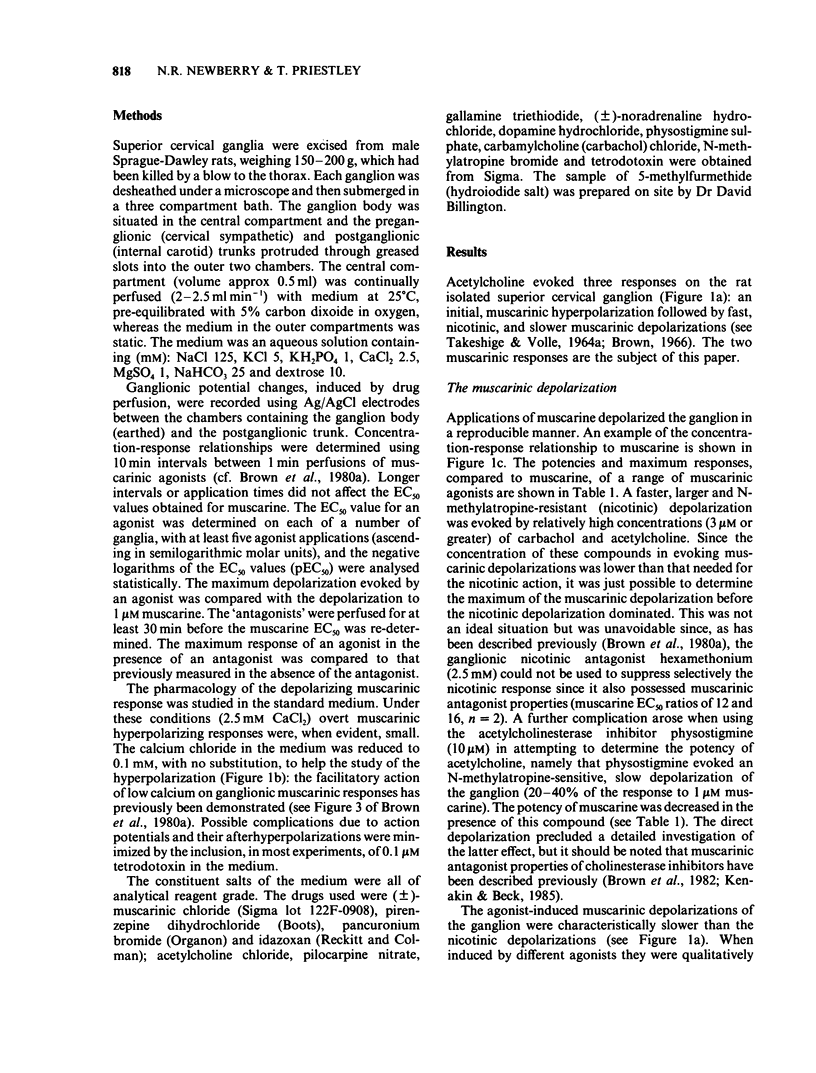
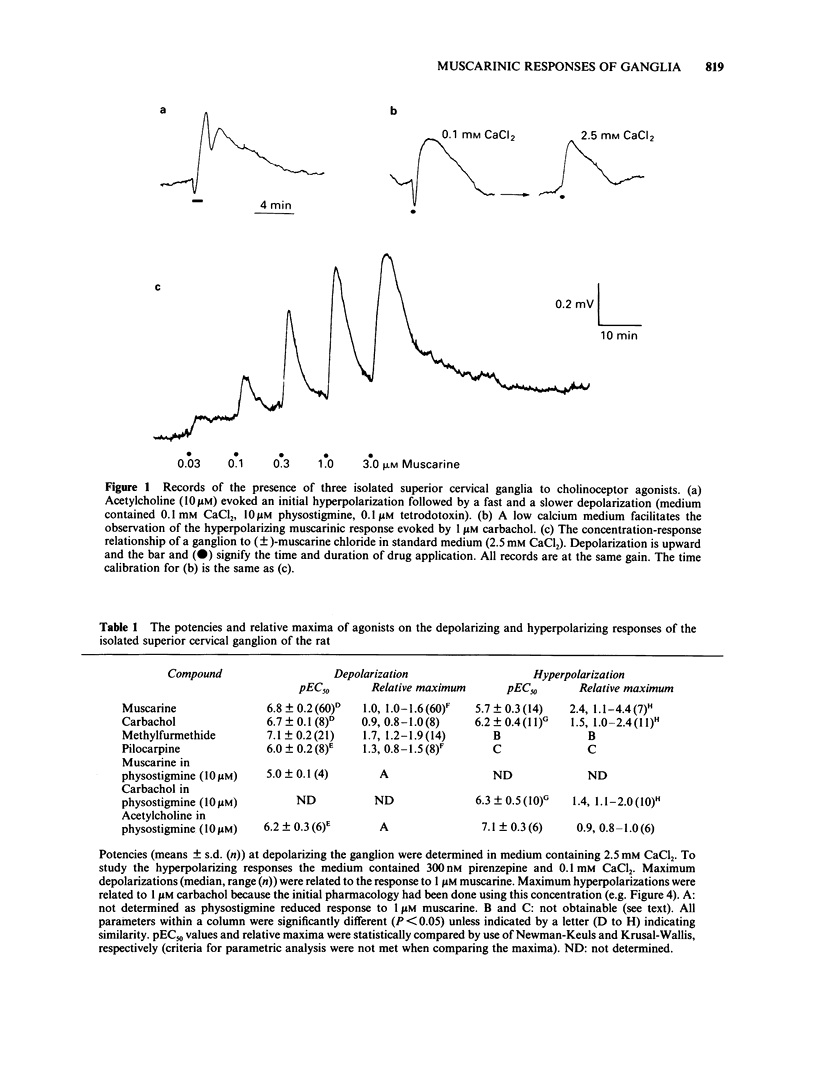

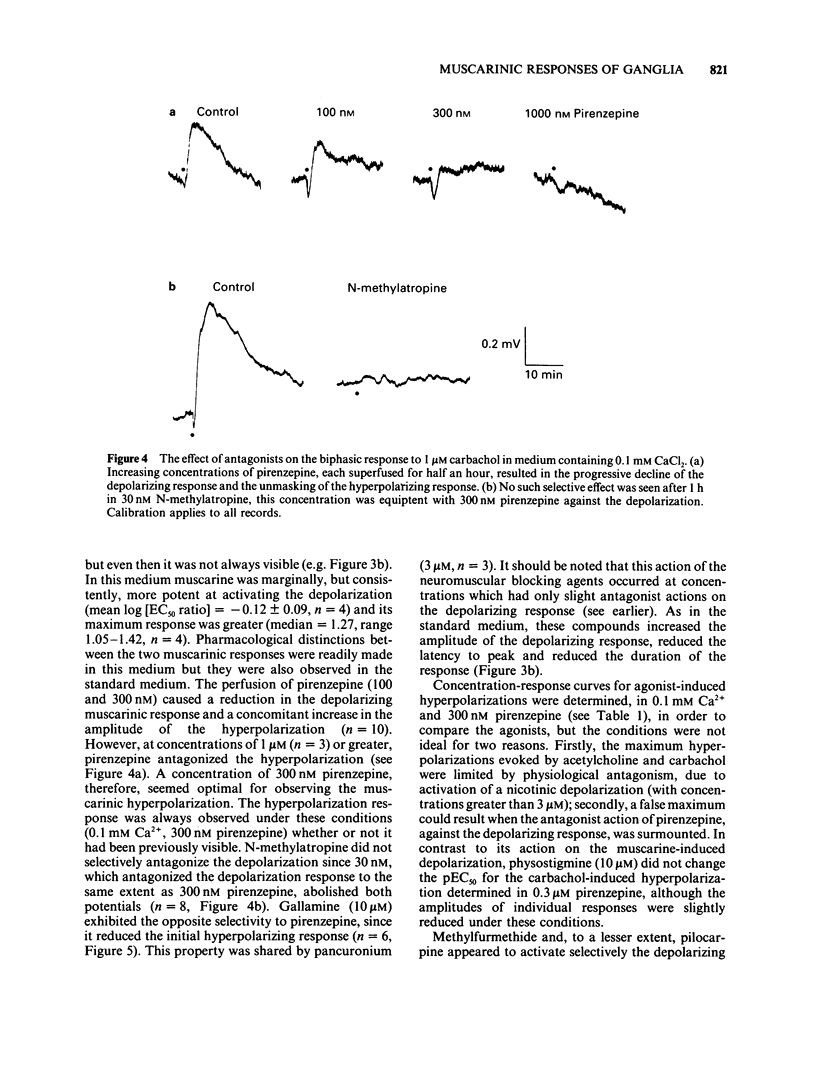
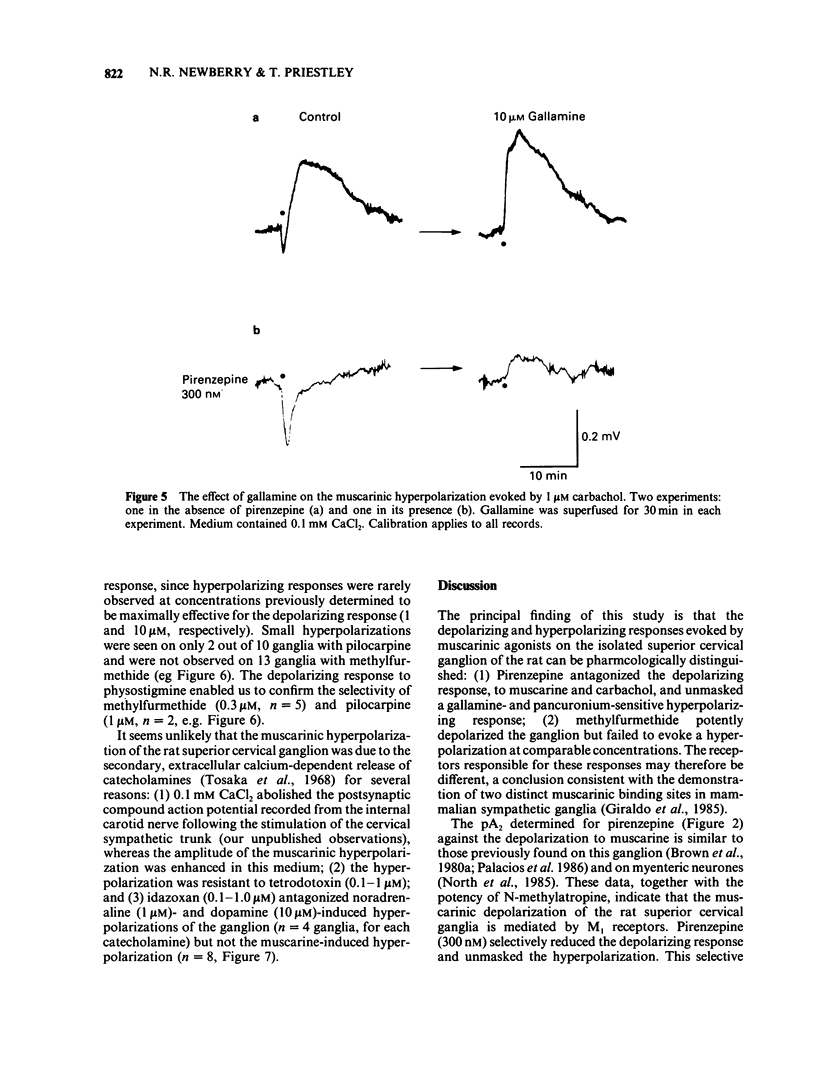


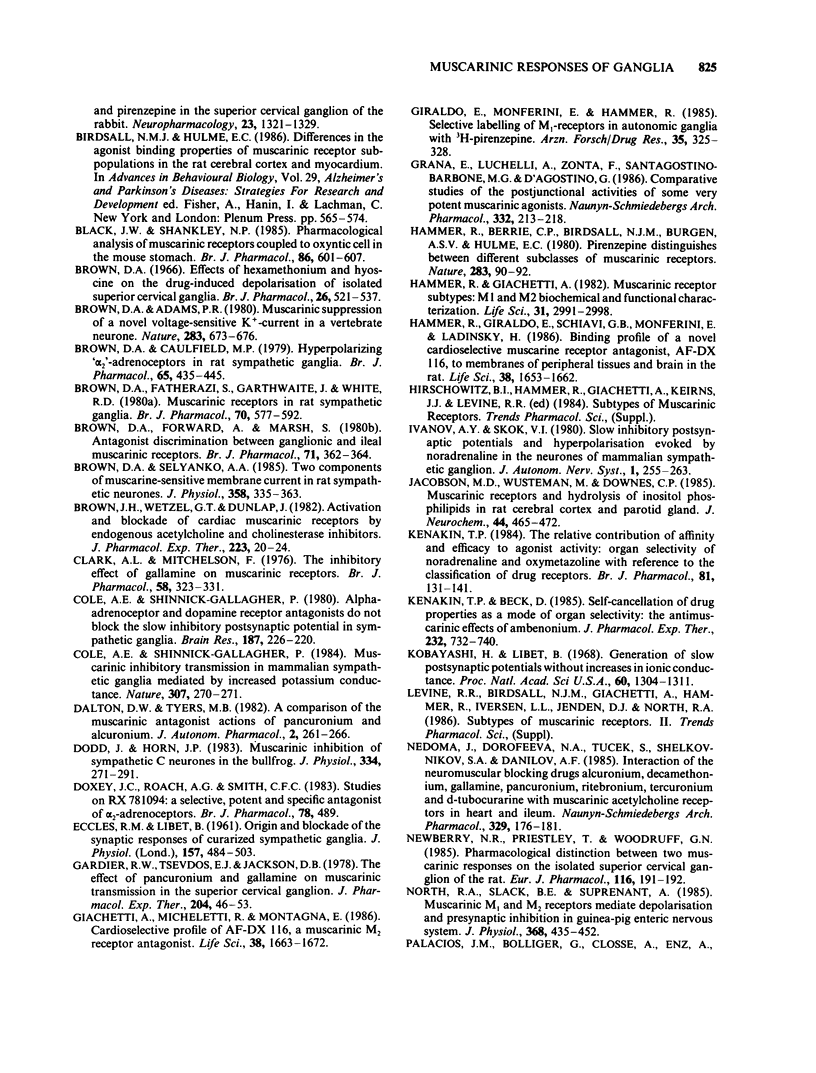
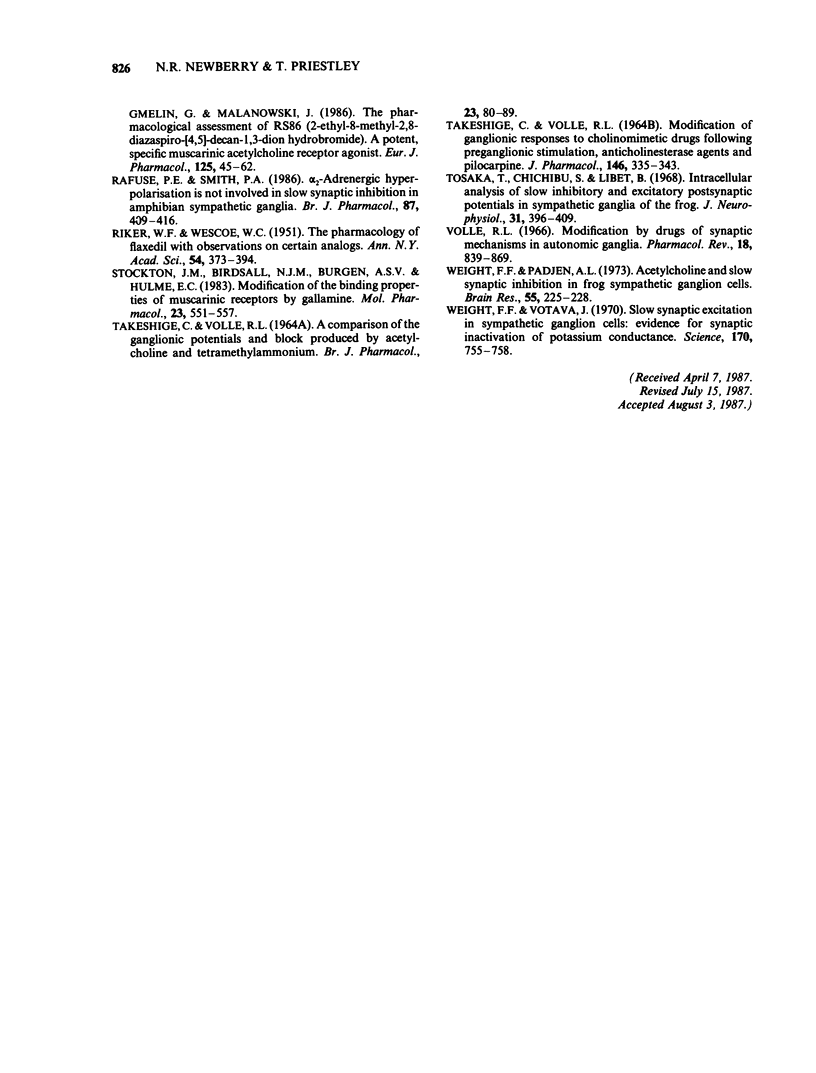
Selected References
These references are in PubMed. This may not be the complete list of references from this article.
- ARUNLAKSHANA O., SCHILD H. O. Some quantitative uses of drug antagonists. Br J Pharmacol Chemother. 1959 Mar;14(1):48–58. doi: 10.1111/j.1476-5381.1959.tb00928.x. [DOI] [PMC free article] [PubMed] [Google Scholar]
- Ashe J. H., Libet B. Pharmacological properties and monoaminergic mediation of the slow IPSP, in mammalian sympathetic ganglion. Brain Res. 1982 Jun 24;242(2):345–349. doi: 10.1016/0006-8993(82)90321-3. [DOI] [PubMed] [Google Scholar]
- Ashe J. H., Yarosh C. A. Differential and selective antagonism of the slow-inhibitory postsynaptic potential and slow-excitatory postsynaptic potential by gallamine and pirenzepine in the superior cervical ganglion of the rabbit. Neuropharmacology. 1984 Nov;23(11):1321–1329. doi: 10.1016/0028-3908(84)90053-4. [DOI] [PubMed] [Google Scholar]
- Black J. W., Shankley N. P. Pharmacological analysis of muscarinic receptors coupled to oxyntic cell secretion in the mouse stomach. Br J Pharmacol. 1985 Nov;86(3):601–607. doi: 10.1111/j.1476-5381.1985.tb08936.x. [DOI] [PMC free article] [PubMed] [Google Scholar]
- Brown D. A., Adams P. R. Muscarinic suppression of a novel voltage-sensitive K+ current in a vertebrate neurone. Nature. 1980 Feb 14;283(5748):673–676. doi: 10.1038/283673a0. [DOI] [PubMed] [Google Scholar]
- Brown D. A., Caulfield M. P. Hyperpolarizing 'alpha 2'-adrenoceptors in rat sympathetic ganglia. Br J Pharmacol. 1979 Mar;65(3):435–445. doi: 10.1111/j.1476-5381.1979.tb07848.x. [DOI] [PMC free article] [PubMed] [Google Scholar]
- Brown D. A. Effects of hexamethonium and hyoscine on the drug-induced depolarization of isolated superior cervical ganglia. Br J Pharmacol Chemother. 1966 Mar;26(3):521–537. doi: 10.1111/j.1476-5381.1966.tb01834.x. [DOI] [PMC free article] [PubMed] [Google Scholar]
- Brown D. A., Fatherazi S., Garthwaite J., White R. D. Muscarinic receptors in rat sympathetic ganglia. Br J Pharmacol. 1980 Dec;70(4):577–592. doi: 10.1111/j.1476-5381.1980.tb09777.x. [DOI] [PMC free article] [PubMed] [Google Scholar]
- Brown D. A., Forward A., Marsh S. Antagonist discrimination between ganglionic and ileal muscarinic receptors. Br J Pharmacol. 1980;71(2):362–364. doi: 10.1111/j.1476-5381.1980.tb10948.x. [DOI] [PMC free article] [PubMed] [Google Scholar]
- Brown D. A., Selyanko A. A. Two components of muscarine-sensitive membrane current in rat sympathetic neurones. J Physiol. 1985 Jan;358:335–363. doi: 10.1113/jphysiol.1985.sp015554. [DOI] [PMC free article] [PubMed] [Google Scholar]
- Brown J. H., Wetzel G. T., Dunlap J. Activation and blockade of cardiac muscarinic receptors by endogenous acetylcholine and cholinesterase inhibitors. J Pharmacol Exp Ther. 1982 Oct;223(1):20–24. [PubMed] [Google Scholar]
- Clark A. L., Mitchelson F. The inhibitory effect of gallamine on muscarinic receptors. Br J Pharmacol. 1976 Nov;58(3):323–331. doi: 10.1111/j.1476-5381.1976.tb07708.x. [DOI] [PMC free article] [PubMed] [Google Scholar]
- Cole A. E., Shinnick-Gallagher P. Alpha-adrenoceptor and dopamine receptor antagonists do not block the slow inhibitory postsynaptic potential in sympathetic ganglia. Brain Res. 1980 Apr 7;187(1):226–230. doi: 10.1016/0006-8993(80)90510-7. [DOI] [PubMed] [Google Scholar]
- Cole A. E., Shinnick-Gallagher P. Muscarinic inhibitory transmission in mammalian sympathetic ganglia mediated by increased potassium conductance. Nature. 1984 Jan 19;307(5948):270–271. doi: 10.1038/307270a0. [DOI] [PubMed] [Google Scholar]
- Dalton D. W., Tyers M. B. A comparison of the muscarinic antagonist actions of pancuronium and alcuronium. J Auton Pharmacol. 1982 Dec;2(4):261–266. doi: 10.1111/j.1474-8673.1982.tb00518.x. [DOI] [PubMed] [Google Scholar]
- Dodd J., Horn J. P. Muscarinic inhibition of sympathetic C neurones in the bullfrog. J Physiol. 1983 Jan;334:271–291. doi: 10.1113/jphysiol.1983.sp014494. [DOI] [PMC free article] [PubMed] [Google Scholar]
- Doxey J. C., Roach A. G., Smith C. F. Studies on RX 781094: a selective, potent and specific antagonist of alpha 2-adrenoceptors. Br J Pharmacol. 1983 Mar;78(3):489–505. doi: 10.1111/j.1476-5381.1983.tb08809.x. [DOI] [PMC free article] [PubMed] [Google Scholar]
- ECCLES R. M., LIBET B. Origin and blockade of the synaptic responses of curarized sympathetic ganglia. J Physiol. 1961 Aug;157:484–503. doi: 10.1113/jphysiol.1961.sp006738. [DOI] [PMC free article] [PubMed] [Google Scholar]
- Gardier R. W., Tsevdos E. J., Jackson D. B. The effect of pancuronium and gallamine on muscarinic transmission in the superior cervical ganglion. J Pharmacol Exp Ther. 1978 Jan;204(1):46–53. [PubMed] [Google Scholar]
- Giachetti A., Micheletti R., Montagna E. Cardioselective profile of AF-DX 116, a muscarine M2 receptor antagonist. Life Sci. 1986 May 5;38(18):1663–1672. doi: 10.1016/0024-3205(86)90410-8. [DOI] [PubMed] [Google Scholar]
- Giraldo E., Monferini E., Hammer R. Selective labelling of M1-receptors in autonomic ganglia with 3H-pirenzepine. Arzneimittelforschung. 1985;35(1A):325–328. [PubMed] [Google Scholar]
- Grana E., Lucchelli A., Zonta F., Santagostino-Barbone M. G., D'Agostino G. Comparative studies of the postjunctional activities of some very potent muscarinic agonists. Naunyn Schmiedebergs Arch Pharmacol. 1986 Mar;332(3):213–218. doi: 10.1007/BF00504856. [DOI] [PubMed] [Google Scholar]
- Hammer R., Berrie C. P., Birdsall N. J., Burgen A. S., Hulme E. C. Pirenzepine distinguishes between different subclasses of muscarinic receptors. Nature. 1980 Jan 3;283(5742):90–92. doi: 10.1038/283090a0. [DOI] [PubMed] [Google Scholar]
- Hammer R., Giachetti A. Muscarinic receptor subtypes: M1 and M2 biochemical and functional characterization. Life Sci. 1982 Dec 27;31(26):2991–2998. doi: 10.1016/0024-3205(82)90066-2. [DOI] [PubMed] [Google Scholar]
- Hammer R., Giraldo E., Schiavi G. B., Monferini E., Ladinsky H. Binding profile of a novel cardioselective muscarine receptor antagonist, AF-DX 116, to membranes of peripheral tissues and brain in the rat. Life Sci. 1986 May 5;38(18):1653–1662. doi: 10.1016/0024-3205(86)90409-1. [DOI] [PubMed] [Google Scholar]
- Ivanov A. Y., Skok V. I. Slow inhibitory postsynaptic potentials and hyperpolarization evoked by noradrenaline in the neurones of mammalian sympathetic ganglion. J Auton Nerv Syst. 1980 Mar;1(3):255–263. doi: 10.1016/0165-1838(80)90021-1. [DOI] [PubMed] [Google Scholar]
- Jacobson M. D., Wusteman M., Downes C. P. Muscarinic receptors and hydrolysis of inositol phospholipids in rat cerebral cortex and parotid gland. J Neurochem. 1985 Feb;44(2):465–472. doi: 10.1111/j.1471-4159.1985.tb05437.x. [DOI] [PubMed] [Google Scholar]
- Kenakin T. P., Beek D. Self-cancellation of drug properties as a mode of organ selectivity: the antimuscarinic effects of ambenonium. J Pharmacol Exp Ther. 1985 Mar;232(3):732–740. [PubMed] [Google Scholar]
- Kenakin T. P. The relative contribution of affinity and efficacy to agonist activity: organ selectivity of noradrenaline and oxymetazoline with reference to the classification of drug receptors. Br J Pharmacol. 1984 Jan;81(1):131–141. doi: 10.1111/j.1476-5381.1984.tb10753.x. [DOI] [PMC free article] [PubMed] [Google Scholar]
- Kobayashi H., Libet B. Generation of slow postsynaptic potentials without increases in ionic conductance. Proc Natl Acad Sci U S A. 1968 Aug;60(4):1304–1311. doi: 10.1073/pnas.60.4.1304. [DOI] [PMC free article] [PubMed] [Google Scholar]
- Nedoma J., Dorofeeva N. A., Tucek S., Shelkovnikov S. A., Danilov A. F. Interaction of the neuromuscular blocking drugs alcuronium, decamethonium, gallamine, pancuronium, ritebronium, tercuronium and d-tubocurarine with muscarinic acetylcholine receptors in the heart and ileum. Naunyn Schmiedebergs Arch Pharmacol. 1985 Apr;329(2):176–181. doi: 10.1007/BF00501209. [DOI] [PubMed] [Google Scholar]
- Newberry N. R., Priestley T., Woodruff G. N. Pharmacological distinction between two muscarinic responses on the isolated superior cervical ganglion of the rat. Eur J Pharmacol. 1985 Oct 8;116(1-2):191–192. doi: 10.1016/0014-2999(85)90204-3. [DOI] [PubMed] [Google Scholar]
- North R. A., Slack B. E., Surprenant A. Muscarinic M1 and M2 receptors mediate depolarization and presynaptic inhibition in guinea-pig enteric nervous system. J Physiol. 1985 Nov;368:435–452. doi: 10.1113/jphysiol.1985.sp015867. [DOI] [PMC free article] [PubMed] [Google Scholar]
- Palacios J. M., Bolliger G., Closse A., Enz A., Gmelin G., Malanowski J. The pharmacological assessment of RS 86 (2-ethyl-8-methyl-2,8-diazaspiro-[4,5]-decan-1,3-dion hydrobromide). A potent, specific muscarinic acetylcholine receptor agonist. Eur J Pharmacol. 1986 Jun 5;125(1):45–62. doi: 10.1016/0014-2999(86)90082-8. [DOI] [PubMed] [Google Scholar]
- RIKER W. F., Jr, WESCOE W. C. The pharmacology of Flaxedil, with observations on certain analogs. Ann N Y Acad Sci. 1951 Oct;54(3):373–394. doi: 10.1111/j.1749-6632.1951.tb39932.x. [DOI] [PubMed] [Google Scholar]
- Rafuse P. E., Smith P. A. Alpha 2-adrenergic hyperpolarization is not involved in slow synaptic inhibition in amphibian sympathetic ganglia. Br J Pharmacol. 1986 Feb;87(2):409–416. doi: 10.1111/j.1476-5381.1986.tb10831.x. [DOI] [PMC free article] [PubMed] [Google Scholar]
- Stockton J. M., Birdsall N. J., Burgen A. S., Hulme E. C. Modification of the binding properties of muscarinic receptors by gallamine. Mol Pharmacol. 1983 May;23(3):551–557. [PubMed] [Google Scholar]
- Tosaka T., Chichibu S., Libet B. Intracellular analysis of slow inhibitors and excitatory postsynaptic potentials in sympathetic ganglia of the frog. J Neurophysiol. 1968 May;31(3):396–409. doi: 10.1152/jn.1968.31.3.396. [DOI] [PubMed] [Google Scholar]
- Weight F. F., Padjen A. Acetylcholine and slow synaptic inhibition in frog sympathetic ganglion cells. Brain Res. 1973 May 30;55(1):225–228. doi: 10.1016/0006-8993(73)90506-4. [DOI] [PubMed] [Google Scholar]
- Weight F. F., Votava J. Slow synaptic excitation in sympathetic ganglion cells: evidence for synaptic inactivation of potassium conductance. Science. 1970 Nov 13;170(3959):755–758. doi: 10.1126/science.170.3959.755. [DOI] [PubMed] [Google Scholar]


